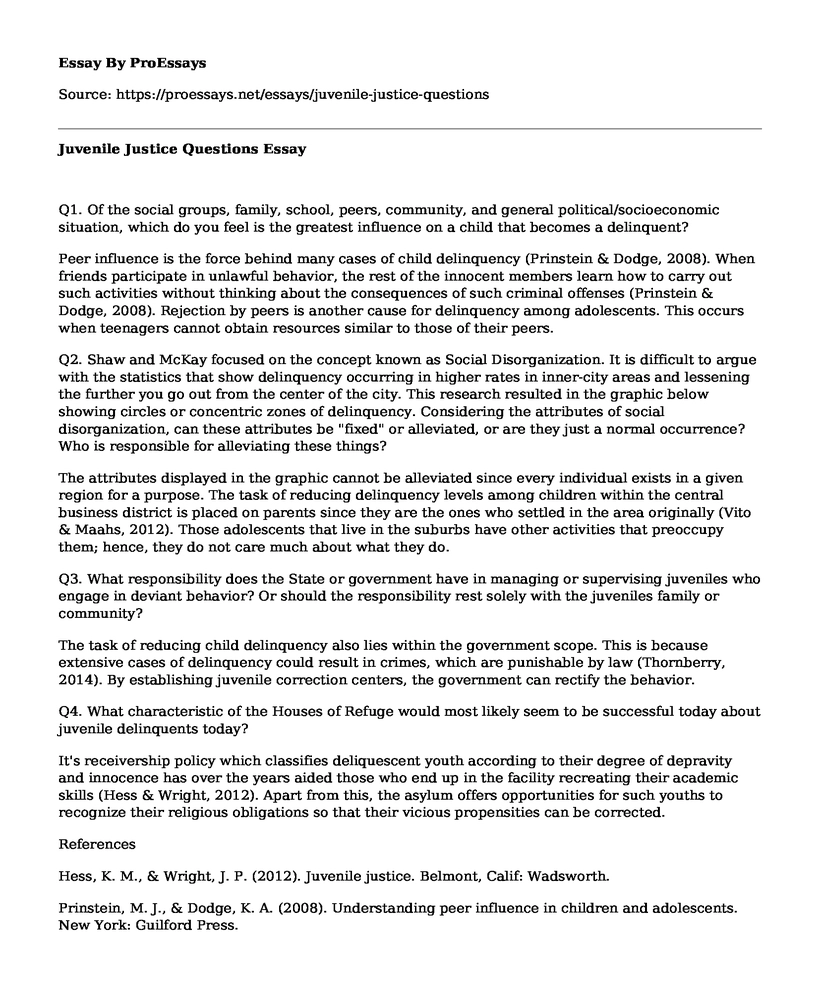Q1. Of the social groups, family, school, peers, community, and general political/socioeconomic situation, which do you feel is the greatest influence on a child that becomes a delinquent?
Peer influence is the force behind many cases of child delinquency (Prinstein & Dodge, 2008). When friends participate in unlawful behavior, the rest of the innocent members learn how to carry out such activities without thinking about the consequences of such criminal offenses (Prinstein & Dodge, 2008). Rejection by peers is another cause for delinquency among adolescents. This occurs when teenagers cannot obtain resources similar to those of their peers.
Q2. Shaw and McKay focused on the concept known as Social Disorganization. It is difficult to argue with the statistics that show delinquency occurring in higher rates in inner-city areas and lessening the further you go out from the center of the city. This research resulted in the graphic below showing circles or concentric zones of delinquency. Considering the attributes of social disorganization, can these attributes be "fixed" or alleviated, or are they just a normal occurrence? Who is responsible for alleviating these things?
The attributes displayed in the graphic cannot be alleviated since every individual exists in a given region for a purpose. The task of reducing delinquency levels among children within the central business district is placed on parents since they are the ones who settled in the area originally (Vito & Maahs, 2012). Those adolescents that live in the suburbs have other activities that preoccupy them; hence, they do not care much about what they do.
Q3. What responsibility does the State or government have in managing or supervising juveniles who engage in deviant behavior? Or should the responsibility rest solely with the juveniles family or community?
The task of reducing child delinquency also lies within the government scope. This is because extensive cases of delinquency could result in crimes, which are punishable by law (Thornberry, 2014). By establishing juvenile correction centers, the government can rectify the behavior.
Q4. What characteristic of the Houses of Refuge would most likely seem to be successful today about juvenile delinquents today?
It's receivership policy which classifies deliquescent youth according to their degree of depravity and innocence has over the years aided those who end up in the facility recreating their academic skills (Hess & Wright, 2012). Apart from this, the asylum offers opportunities for such youths to recognize their religious obligations so that their vicious propensities can be corrected.
References
Hess, K. M., & Wright, J. P. (2012). Juvenile justice. Belmont, Calif: Wadsworth.
Prinstein, M. J., & Dodge, K. A. (2008). Understanding peer influence in children and adolescents. New York: Guilford Press.
Thornberry, T. P. (2014). Interactional theory of delinquency. In Encyclopedia of criminology and criminal justice (pp. 2592-2601). Springer New York.Vito, G. F., & Maahs, J. R. (2012). Criminology: Theory, research, and policy. Sudbury, Mass: Jones & Bartlett Learning.
Cite this page
Juvenile Justice Questions. (2021, Mar 04). Retrieved from https://proessays.net/essays/juvenile-justice-questions
If you are the original author of this essay and no longer wish to have it published on the ProEssays website, please click below to request its removal:
- The Stereotypes versus Reality of People with Tattoos: Essay Sample
- Legalized Medical Use of Marijuana to Treat Cancer or MS Essay Example
- Access to Shelter - Essay Sample
- Essay Sample on Competence With Indigenous Counseling
- Reconciliation by Polly Clark Essay
- Race & Identity: How Morality Influences Our Decisions - Essay Example
- Reading in English as a Foreign Language - Essay Example







